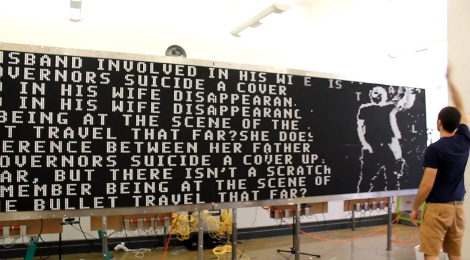This huge and mesmerizing interactive display is just a big piece of advertising. It is a flip-dot display. Each pixel is a mechanical disk, white on one side and black on the other. The team over at BreakfastNY hacked the display modules and wrote their own software so that it can be refreshed with lighting quickness. To the left you can see the high contrast text, but on the right it’s showing the camera-based interactivity. A few seconds later this gentleman sweeps his arm to the side and all the pixels scatter as if blown away by a forceful wind. You might as well just skip down to the video after the break right now.
The display is an advertisement for a new show on the TNT network called Perception. We’ve got to say, if you’re going to advertise this is the way to do it. Make something cool, then share the details. We get to enjoy the clickity-clack of all those dots flipping into place and they got us to at least recognize the network and say the name of the show. Everyone wins.
[Thanks Itamar via Engadget]
















…simply amazing. I’m not sure if any other words are needed.
That’s pretty amazing, if only for the sheer scale – it’s a shame they don’t provide more details on how they engineered the architecture to do such fast animations, and who they sourced the modules from. Not many companies make those boards anymore…in fact, they’re virtually impossible to find, especially for sale. About the only ones I’ve ever seen have been old bus displays that pop up on ebay once in a blue moon.
http://www.flipdots.com/flip-dot-boards-xy5-14×28.html
for those interested where to get more
Thanks for the link, but no prices listed. Anyone have an idea what a single panel costs?
Updated with an email from the company I linked:
Thank you for your interest. A board 14×28/0.53″ is listed at 450 EUR. This
includes display board and driver electronics with RS485 interface. You need
24V power supply.
There are different options for controllers that are resulting in different
driving speed.
We can also supply individual strips at 4 EUR/each (7 dots).
These are list prices, excl. shipping or taxes.
Each project is however different and I would prefer to speak directly with
interested people/companies to offer them the most suitable solutions.
Marcin KRYSIŃSKI
Alfa-Zeta Sp. z o.o.
ul. Starorudzka 6a
93-418 Łódź, POLAND
tel. +48 42 6891200
fax +48 42 6891202
http://www.alfazeta.pl
info@alfazeta.pl
Is this Kinect controlled or do they just use a regular camera?
From the video it looks like they are using two ASUS Xtion Pro Live cameras. The Kinect and the Xtion both use the same PrimeSense sensor.
Looks like a regular camera, or one every few feet of panel. Subtract the incoming image from the background, apply an edge detect filter and scale and convert to 2 color.
Very neat effect though with the text falling away.
Color based background subtraction isn’t trivial. I think they are thresholding a depth image to remove the background and thresholding a color image to produce the binary image.
We did it before with an FPGA. It wasn’t really difficult: we converted the image to greyscale before subtracting from the buffered image. The buffer stored the mean greyscale image from the previous 60 or so frames, so if you stood still in front of the camera you faded into the background.
imagine if we had these types of displays (if tube monitors or lcds were never invented). if we had a dead pixel, at least we might be able to fix it ourselves.
We may be able to fix it ourselves, but we might spend more time fixing than viewing the display. With transparent color disks illuminated from behind,color could be achieve, but poorly.
Exactly. Mechanical dots are cool, but noone wants 2-color displays, especially not on the larger displays. I work for a company that makes the giant LED displays, and we actually did make the mechanical dot displays – decades ago. The market simply doesn’t want those anymore.
These are still used in some highway information signs where I live. Always wondered how they worked, but didn’t know the name of the tech to look up. Thanks to this, now I do.
Here’s the Wikipedia article in case anyone is curious to see further details.
@ddh819
The kinotrope displays in the seminal steampunk novel “The Difference Engine” were basically this, only fully mechanical rather than electromechanical
thank you hackaday and had readers for the info, intresting read!
I reckon this would be ideal for running a large scale Conway GOL simulation – complete with a built-in, soothing white-noise soundtrack.
Cool toy.
So… boss…
Not quite the same thing but I always liked the flip display type computer in Barbarella. Always wondered how they made that one.
http://www.tcm.com/mediaroom/video/191401/Barbarella-Movie-Clip-Rise-and-Shine.html
More flipdotty awesomeness :
http://troika.uk.com/cloud
Great video! Great experience!
i would like to know how to get my hands on some software to drive the things. i scored a row of panels from an old bus and want to build something with it.
Great video! Very cool software.
A much bigger version is in Thailand (True Corp), 13m x 6m high. Much bigger dots. Made by an Australian company (AD Engineering). Similar in concept with people moving across the screen, but software not as good the one above.
hi
here is a link to another hack
https://vimeo.com/80226022